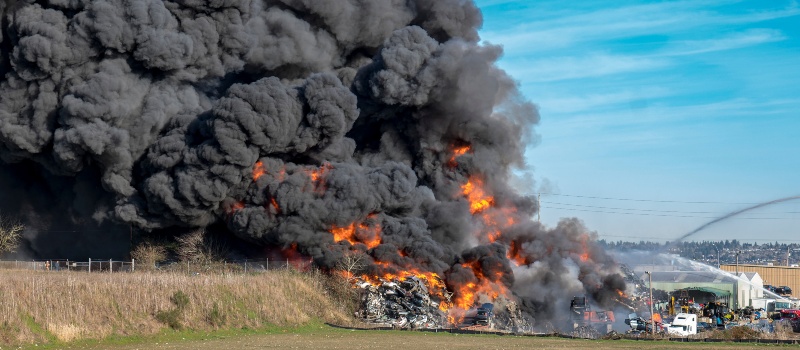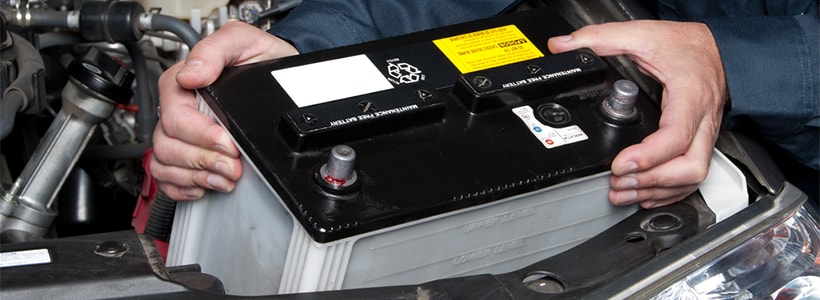
Why are scrap yard fires so dangerous?
19th Nov, 2019
Every so often, you’ll see a scrapyard fire that becomes big news. If you’re unlucky enough to be local to one, it’s rarely difficult to miss them, as they can produce great writhing columns of smoke that are visible for miles around. The scrap yard fire in Newark, Nottinghamshire was one recent example. So, you may be asking, how can such a mighty blaze spring from the unassuming business where I plan to scrap my car? (Although it’s a possibility you might not phrase it quite like that.)
Well, the severity of blazes at scrap yards often comes down to the significant amount of flammable material on site, and how and where it’s stored. Waste management and storage is actually such a big factor in controlling fires that the government levels hefty fines at any scrap car operators found to be using unsafe practices, and it’s a vital prerequisite of the Authorised Treatment Facility licence that all scrapyards must hold in order to legally be allowed to operate. Here’s just a sample of what can go up in smoke at a scrapyard, and why it’s such a big problem.
1. Tyres
You don’t need a science degree to know that tyres are highly flammable, being made of rubber. The fire risk they pose can be frequently underestimated by members of the public, and even sometimes by scrap car dealers themselves.
When they catch fire, they can end up releasing chemicals and hazardous waste into the surrounding area and ecosystems, causing harm to human and animal life alike. For this reason alone, there’s very strict limitations on how many tyres can be stored on a single site at once. Scrap car breakers can be subject to strict fines (or even prosecution) if they breach these limits.
2. Wood and paper
Both infamously flammable materials, scrapyards can be home to a fair amount of wood and paper, especially if breaking cars isn’t their only source of income. These materials can be those they’ve harvested from cars, or some other source, and can be in the form of loose waste (such as chips) or more solid items like pallets. Either way, if they get in the bath of a blaze, they’re usually amongst the first to go up in flames. At least there’s a positive flipside – they’re generally easier to extinguish!
3. Oils and hazardous fluids
The global car recycling industry processes 80 million gallons of hazardous fluids every year, which means it’s a safe bet that there’s always at least some being stored on site at an average scrapyard. This includes paints, solvents, motor oil, coolant, and fuel such as petrol or diesel. Any one of them can easily become the source of a fierce blaze, and similarly release highly toxic gases into the atmosphere. Gas cylinders and flammable liquids containers are the bane of many firefighters – just last year, a waste tanker caused a whole workshop full of scrap cars to be destroyed at a site in Bristol.
4. Metals
We touched upon the devastating Newark blaze earlier on, in which thankfully no lives were lost. For firefighters, one of the toughest parts of tackling that blaze was dealing with the amount of metals involved. While you might not think of most metals as being easily flammable, we may surprise you – there are plenty of metals which can catch fire! The Newark blaze, for example, involved steel, lead, brass, aluminium, copper, bronze and tin.

This is because most metals combine with oxygen to some extent, such as during the corrosion or rusting process. However, this usually happens over a significant length of time. Under the right conditions though, where temperatures are hot enough, almost any metal can combust. It’s especially problematic when the metal is ground up into dust, called swarf, as normal fire extinguishers aren’t always the best way to put out these kind of fires. More often than not, they’ll do nothing more than move the swarf around, basically blasting tiny bits of flaming metal into the air. For this reason, special fire extinguishers are sometimes required, especially for those metals which are a great deal more reactive than others.
Magnesium is highly flammable, for example, and firefighters reserve a particular dislike for it. We won’t get too deeply into the science, but basically burning magnesium oxidises when it comes into contact with water, separating the molecules and making the blaze even worse. Complicating things for scrap car dealers is the fact that magnesium is often used in engine parts, so is a near-constant fire hazard. Firefighters often used dry powder agent or sand to put out magnesium fires, but in the case of the Newark blaze they were left with no option but to simply let it burn itself out.
5. Car batteries
Lithium-ion batteries can often be another major culprit for scrapyard fires. In 2017, 100 tonnes of metal and a crane went straight up in smoke at a Suffolk scrapyard – which firefighters have said may have been started by a battery. Again, this involves a bit of science knowledge to fully understand, but we’ll give you the simple version about why they’re quite so dangerous.
Basically, lithium-ion batteries hold a lot of power, which is what makes them the top choice for everything from automobiles to phones and laptops. Every cell in these types of lithium-ion batteries contains a flammable liquid electrolyte. If a cell short circuits, it can combust and the pressure within the cell will build until finally the cell vents flammable electrolyte. This can be a key factor in fires that eventually consume whole scrapyards.

While it all may sound quite unnerving, you’ll be pleased to hear that all Authorised Treatment Facilities – includingour partners here at Scrap Car Network – go to great lengths to identify and manage these risks. You can find out more about it in our post about how we keep our scrapyards safe. Alternatively, if you’ve come here first and foremost to scrap your car, you can get an instant online quote on our homepage! Curious to find out how much your car is worth?